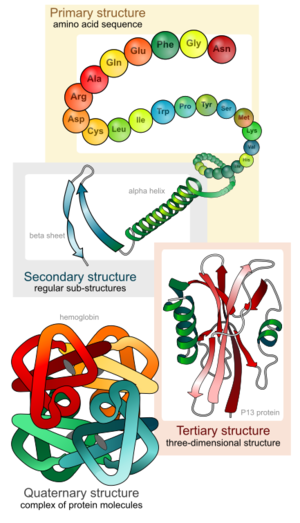Protein (nonfiction): Difference between revisions
Jump to navigation
Jump to search
No edit summary |
|||
| Line 7: | Line 7: | ||
== Fiction cross-reference == | == Fiction cross-reference == | ||
<gallery mode="traditional"> | |||
File:Myoglobin John Kendrew.jpg|link=You and whose protein?|Biochemist and crystallographer John Kendrew setting up a [[You and whose protein?|perimeter defense of myglobin spikes]]. | |||
</gallery> | |||
* [[You and Whose Protein?]] - a [[catch phrase]] | * [[You and Whose Protein?]] - a [[catch phrase]] | ||
Revision as of 11:59, 10 June 2016
Proteins (/ˈproʊˌtiːnz/ or /ˈproʊti.ᵻnz/) are large biomolecules, or macromolecules, consisting of one or more long chains of amino acid residues.
Description
Proteins perform a vast array of functions within living organisms, including catalysing metabolic reactions, DNA replication, responding to stimuli, and transporting molecules from one location to another.
Proteins differ from one another primarily in their sequence of amino acids, which is dictated by the nucleotide sequence of their genes, and which usually results in protein folding into a specific three-dimensional structure that determines its activity.
Fiction cross-reference
Biochemist and crystallographer John Kendrew setting up a perimeter defense of myglobin spikes.
Nonfiction cross-reference
External links
- Protein @ Wikipedia


